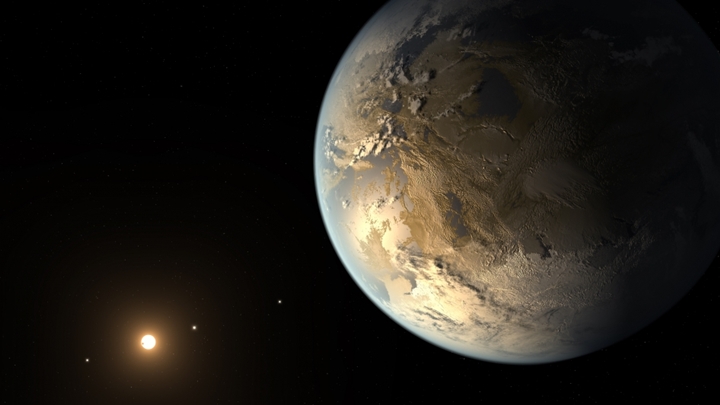
Searching distant space with NASA's Kepler Space Telescope, astronomers have discovered the first planet, about the size of Earth, orbiting a star in the "Goldilocks zone" -- the distance from a star where liquid water might pool on the surface of a not too hot, not too cold planet, and conditions are thought to be just right for supporting life.
The discovery of Kepler-186f confirms that Earth-sized planets exist in the habitable zones of stars other than our sun, but whether or not life could exist there is still up for speculation.
According to NASA, The Kepler Telescope has also discovered more than 1,000 new planet candidates, nearly doubling its previously known count. Ten of these candidates are near-Earth-size and orbit in the habitable zone of their host star. Some of these candidates require follow-up observations to verify they are actual planets, though.
"This is a major milestone on the road to finding Earth's twin," said Douglas Hudgins, Kepler program scientist at NASA Headquarters in Washington. "Kepler's results continue to demonstrate the importance of NASA's science missions, which aim to answer some of the biggest questions about our place in the universe."
"The discovery of Kepler-186f is a significant step toward finding worlds like our planet Earth," said Paul Hertz, NASA's Astrophysics Division director at the agency's headquarters in Washington. "Future NASA missions, like the Transiting Exoplanet Survey Satellite and the James Webb Space Telescope, will discover the nearest rocky exoplanets and determine their composition and atmospheric conditions, continuing humankind's quest to find truly Earth-like worlds."
Although the size of Kepler-186f is known, its mass and composition are not. Previous research, however, suggests that a planet the size of Kepler-186f is likely to be rocky.
"We know of just one planet where life exists -- Earth. When we search for life outside our solar system, we focus on finding planets with characteristics that mimic that of Earth," said Elisa Quintana, research scientist at the SETI Institute at NASA's Ames Research Center in Moffett Field, Calif., and lead author of the paper published today in the journal Science. "Finding a habitable zone planet comparable to Earth in size is a major step forward."
"If you were to live on Kepler-186f, with an atmosphere like Earth's, it would be like living in San Francisco on a cold day," Quintana also told USA Today, "We don't consider it Earth's twin. We consider it more of Earth's cousin."
According to the scientist, Kepler-186f circles a common type of star known as an M-dwarf, or Red Dwarf. M-dwarf stars make up about 70 percent of the stars in the universe, but, according to wikipedia, not one is visible to the naked eye because of their dimness. This particular star, which lies in the constellation Cygnus, is invisible to the naked eye, but you can see it with powerful binoculars.
"Anyone that's there will need a hard hat," jokes Don Pollacco, a planetary scientist at Britain's University of Warwick and the head of the science team for a future European planet-hunting mission. " The radiation field will be pretty intense. If there's life there, it's going to be quite different."
According to Pollacco, the star, although dim, emits powerful radiation spikes that would make living on a planet orbiting it quite a harsh ordeal.
The newly discovered planet sits in the cooler part of its habitable zone, which means it would have to have a very thick, warming atmosphere of a substance such as carbon dioxide, to supports water, says Abel Méndez of the University of Puerto Rico at Arecibo.
"But even if the temperature is right for life, we don't know of any complex life (plants and animals) that can survive such toxic levels of CO2," Méndez told USA Today.
Kepler-186f resides in the Kepler-186 system, about 500 light-years from Earth in the constellation Cygnus.
NASA reports that Kepler-186f orbits its star once every 130 days and receives one-third the energy from its star that Earth gets from the sun, placing it nearer the outer edge of the habitable zone. On the surface of Kepler-186f, the brightness of its star at high noon is only as bright as our sun appears to us about an hour before sunset.
The next step for NASA in the search for distant life include looking for true Earth-twins -- Earth-size planets orbiting within the habitable zone of a sun-like star -- and measuring their chemical compositions. The Kepler Space Telescope, which simultaneously and continuously measured the brightness of more than 150,000 stars, is NASA's first mission capable of detecting Earth-size planets around stars like our sun.
If you would like to learn more, check out NASA's Kepler mission here.














